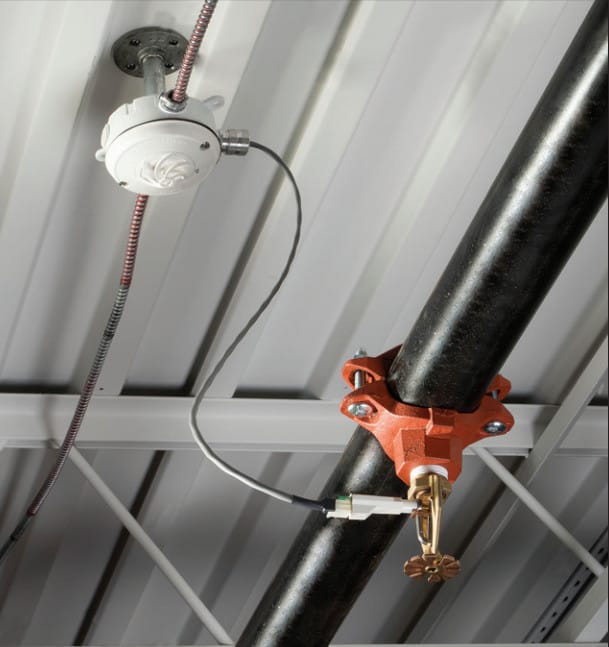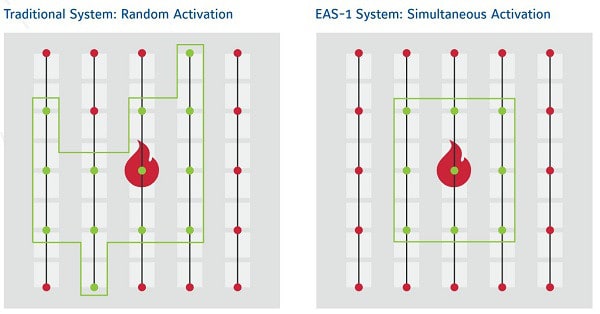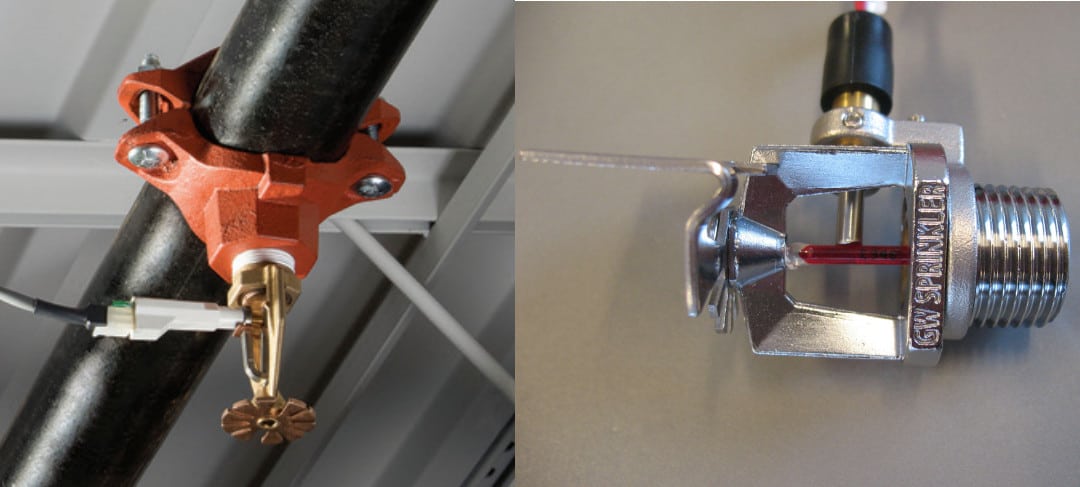Electrically operated sprinklers activate in concert with separate detectors and have particular applications
Despite many refinements and advances, the basic activation mechanism of most fire sprinkler heads hasn’t changed much since their invention in 1876. They rely on an integrated thermosensitive element (a soldered link or glass bulb) to hold back the water until the heat from a fire causes it to melt or break. But electrically operated fire sprinklers (also called electrically activated sprinklers, and sometimes “smart sprinklers”) are a new technology that switches up this fundamental design.
As the name reveals, an electric signal causes the sprinkler to operate. In the event of a fire, fire-detection sensors communicate with a control panel that “decides” which sprinklers need to activate and sends a signal to do it. The goal is for sprinklers to activate faster and more accurately, enabling greater protection of high-challenge environments.
This article examines how these new sprinklers work, when and how they’re useful, and what key National Fire Protection Association (NFPA) standards have to say about them. We’ll refer to the technology offered by two primary manufacturers in the field—Tyco (aka Johnson Controls), which provides a complete listed EAS-1 system, and the Danish company GW Sprinkler, which makes electronically actuated sprinkler heads.
Need traditional and time-tested fire protection equipment? Shop our selection of commercial and residential sprinklers, escutcheons, cover plates, and more for your next installation or repair. For more information on fire sprinklers for storage areas, ESFR sprinklers, and different specialty sprinklers, see our previous blog posts.
How electrically operated fire sprinklers work
It’s helpful to think of “electrically operated sprinklers” not just as a sprinkler head but as a system with multiple components. The system relies on sprinkler heads, sensors, and a control panel, all working together to deliver water to a fire. As we’ll discuss later, NFPA 13 treats electrically operated sprinklers as a cohesive system that is tested and listed as a unit. The heads are not standalone hardware.

Electrically activated sprinkler heads are mostly similar to analog ones except for a critical difference: the operating element uses an electrical mechanism instead of or alongside a traditional heat-sensing element.
Tyco’s EAS-1 sprinklers (TY720 and TY920) are early suppression, fast response ESFR sprinklers (a type you can read more about here). But their operation entirely depends on an electrical signal from an accompanying control panel—they don’t have an integrated heat-sensing element. These sprinklers are tested specifically for storage occupancies.
In contrast, GW Sprinkler offers dual-action sprinklers capable of activating as standard with a glass bulb element or by an electrical signal from a component called a Metron actuator, which breaks the bulb with a small pyrotechnic charge.
Because electrically operated sprinklers don’t have integrated heat-sensitive elements, they require a control panel and a network of sensors. Tyco’s system gives a good example of how sensors and the control panel interact. Each EAS-1 sprinkler is wired to its own heat sensor, which is, in turn, wired into the control panel. As many as 3,000 sensors can be connected to a single panel.

As GW Sprinkler says, an electrically activated sprinkler system could involve smoke detectors, heat detectors, or flame detectors (or some combination). However, commentary in the 2023 edition of NFPA 25 (section 3.3.41.5) only refers specifically to heat sensors. At this time of writing, Tyco is the only company with a complete listed system of sprinklers, detectors, and control panels, and it exclusively uses heat sensors.
What problem do these new sprinklers solve?
While different manufacturers envision different use cases, electrically operated sprinklers are currently generally intended to act quickly and efficiently to protect high-challenge environments like storage facilities.
Both GW Sprinkler and Tyco claim that their technologies enable sprinklers to activate faster than traditional sprinkler heads. The premise is that electronic sensors (like heat or flame detectors) can detect fire quickly and activate sprinkler heads instantaneously, getting water on the fire faster. This speed contrasts with traditional sprinkler heads, which depend on sustained elevated temperatures near the sprinkler to burst a bulb or melt a soldered link.
Besides quicker activation, Tyco states that electronic control reduces the potential randomness of sprinkler operation, providing more efficiency. With traditional, tightly spaced sprinklers, water droplets from one activated sprinkler may cool the thermal element of another (called “water drop impingement”), which causes a phenomenon called sprinkler skipping. Heads further from the fire operate before (or instead of) some that are closer and delay and inhibit fire suppression or control. Tyco’s electrically activated sprinklers claim to avoid this issue; the control panel activates only those sprinklers (between 6 and 9 of them) that specific heat detectors indicate are needed to address a fire.

By activating sprinklers sooner and reducing the number of unneeded activations, electronic systems aim to protect high-challenge environments better.
If heads go off earlier, the fire is smaller and thus easier to control or suppress. And if only the necessary sprinklers activate, all the available water pressure goes towards fire control or suppression, and the volume and associated water damage are minimized. This could enable designers to implement a “smaller” and less expensive system than would otherwise be needed. And there may be a particular use case for systems that owners must retrofit because of a structure’s “change of use” that requires new system design criteria.
For example, Tyco’s EAS-1 system is explicitly designed for high-challenge storage facilities. We’ve previously written about the challenge of protecting storage environments and how ESFR sprinklers provide protection without using in-rack sprinklers. Effectively, Tyco states its EAS-1 system combines ESFR sprinklers with electric sensing and activation to protect storage areas that might otherwise require expensive fire pumps, in-rack fire sprinklers, or more expensive retrofits.
Design standards for electrically activated sprinklers
Sprinkler system design depends on choices and calculations that ensure enough water (in terms of flow rate and pressure) comes through the pipes and sprinkler heads to control or suppress a fire. NFPA 13: Standard for the Installation of Sprinkler Systems (references to the 2022 edition) gives engineers detailed design criteria for all kinds of sprinkler systems, including standard spray systems and different storage systems. But it doesn’t (yet) provide detailed, specific design criteria for electrically operated sprinkler systems.
Electrically operated sprinklers are a pretty new technology, so their first mention in NFPA 13 is in the latest and current (as of this writing) 2022 edition. Besides providing a definition (3.3.215.4.6), the standard only has section 15.6 on their allowable use:
From the 2022 edition of NFPA 13
15.6 Electrically Operated Sprinklers.
Electrically operated sprinklers shall be permitted where such devices have been evaluated and listed for performance under the following conditions:
(1) Fire tests related to the intended hazard
(2) Distribution of the spray pattern with respect to wetting of floors and walls
(3) Distribution of the spray pattern with respect to obstructions
(4) Performance under horizontal or sloped ceilings
(5) Area of design
(6) Allowable clearance to ceilings
Essentially, there are no universal, specific design criteria.
Instead, electrically operated sprinklers are allowed in situations where they have been tested and listed. Many parts of a fire sprinkler system must be listed, which means they meet criteria from groups like UL or FM Global. Before a device can achieve this status, it must be tested for functionality and safety by a testing laboratory.
Thus, when NFPA 13 states that electrically operated sprinklers are permitted when they’re “evaluated and listed for performance,” it means the standard defers to the testing laboratory to approve both the device itself and the possible/applicable design criteria. The list under section 15.6 defers to site-specific considerations and labs to establish how these sprinklers perform against real fires with challenges like obstructions, sloped ceilings, and tall storage. In effect, the listing may be for the entire sprinkler system, not just the sprinklers.
For example, the datasheet for the Tyco EAS-1 system includes design criteria much like what you see in NFPA 13’s chapters governing storage sprinklers. It details:
- Minimum and maximum sprinkler cover area
- Water supply duration
- Sprinkler-spacing criteria
- Max ceiling and storage height
- Minimum spacing of aisles
- Design area and design pressure rules
- Types of commodities that can be protected
UL has tested and listed the EAS-1 electric sprinkler systems under specific conditions and determined they work within these parameters.
In contrast, GW Sprinkler states that “Care must be exercised that RTI, orifice size, temperature rating, deflector style and sprinkler type is in accordance with the latest published sprinkler installation standards i.e. EN12845, CEA4001 or NFPA13.” (CEA 4001 and EN 12845 are European fire sprinkler installation standards).
The company specifies these heads are “ideal for applications where instant and fully controllable actuation of single or multiple heads is called for – e.g. applications involving protection of explosive components/environments.” Further, the sprinklers and Metron Actuators are approved by the LPCB (Loss Prevention Certification Board), which is a European equivalent to UL.
Thus, the design criteria for installations that reflect a particular, appropriate hazard and application according to NFPA 13 (or alternative standards mentioned) would apply, as long as the authority having jurisdiction accepts LPCB approval as meeting the NFPA definition of “listed.”
Inspection, testing, and maintenance of electrically operated fire sprinklers
We can’t talk about a new type of sprinkler system without mentioning its required upkeep. NFPA 25: Standard for the Inspection, Testing, and Maintenance of Water-Based Fire Protection Systems (references to the 2023 edition) first mentioned electrically operated fire sprinklers in the 2020 edition, and the 2023 edition made no changes to its initial requirements beyond one. The latest edition added an inspection that mirrors other sprinkler types:
5.2.1.5 Electrically operated sprinklers shall be inspected from the floor level annually in accordance with 5.2.1.1 and the manufacturer’s requirements.
Section 5.2.1.1 just details the annual inspection “from the floor level,” which means individuals don’t need to get on ladders, and NFPA 25’s enhanced content cautions that “inspectors who use a flashlight or binoculars must be careful about false positive results.”
It’s not perfectly clear whether the standard intends for inspectors to follow any of the rest of the inspection criteria in sections under 5.2.1.1, however, and some of these items (but not others) make sense. For example, finding a sprinkler installed in the incorrect orientation would always be a problem requiring correction (5.2.1.1.2). In contrast, “loss of fluid in the glass bulb heat-responsive element” doesn’t apply at all to Tyco’s electrically operated sprinklers because they don’t have one, whereas it theoretically might to GW Sprinkler’s Metron-activated models—they have a glass bulb. Still, it’s not the primary way they activate.
Fortunately, both manufacturers clear up this issue somewhat with particular inspection requirements that mirror some of NFPA 25.
Tyco EAS-1 says an inspection must ensure no objects hang from sprinklers, do not have visible signs of corrosion or leakage, and are not “painted, plated, coated, or otherwise altered after leaving the factory.” Heads can also only be cleaned lightly with a feather duster—a difference from NFPA 25, which requires touchless cleaning (A.5.2.1.1.1). GW has all those same inspection requirements, including the feather duster guidance, plus “replace any sprinkler that has a cracked bulb or has lost liquid from its bulb.”
Overall, NFPA 25’s two basic instructions for smart sprinklers and systems are: defer to the manufacturer’s instructions and coordinate with NFPA 72’s ITM requirements. NFPA 72: National Fire Alarm and Signaling Code (currently in the 2022 edition) covers ITM for the control panel, sensors, and other aspects.
The latter illustrates one possible drawback of electrically operated sprinkler systems that narrows their application: they essentially require a fire alarm control panel/detection system and come with the additional administrative and technical burdens of NFPA 72. This may not be a big deal in high-challenge environments where detectors and alarms are already required. But it illustrates why electrically activated sprinklers haven’t been developed for many other occupancies and hazard levels that only need simpler setups.
Other than the inspection requirements, Tyco provides additional essential ITM rules for its EAS-1 system:
- Samples sprinklers should be submitted to UL for testing starting five years after manufacture, then 10 years, then annually after the 10th year. It’s similar to what we describe in this article on NFPA 25 sprinkler testing—but relatively frequent compared to most other sprinkler types.
- Sample heat sensors are tested five years after manufacture, then 10 years after manufacture, and then annually after the 10th year. This testing is done onsite, not in a lab.
- Control panels should be maintained according to NFPA 72. Tyco also recommends that quarterly temperature reports be taken from the panel to check for any anomalies.
For their part, GW-S sprinklers have this additional note about testing: “The heat & electrically operated sprinkler head is a one shot device, and cannot be functionally tested. The Metron Actuator can be [electrically] supervised,” however.
As other manufacturers enter this market, they will put forth their own sprinklers, systems, and ITM requirements. And NFPA may eventually standardize and detail the criteria for all of them.
A novel fire protection technology with very specific applications
Electrically operated fire sprinklers are a new twist on fire sprinkler design. For the time being, these systems are primarily aimed at protecting high-challenge areas more efficiently, such as by avoiding using in-rack sprinklers. That could eventually change, however. More building types might employ these systems as technology advances and if the costs or maintenance requirements for networked detectors and control panels ease.
But for now, the plain old traditional fire sprinkler still rules the market. It’s a simple, reliable, and time-tested technology that works incredibly well in most applications, including those only requiring sprinklers and not alarm systems.
For your next installation or repair, shop our selection of fire sprinkler heads, tools, and accessories. Also, check out our previous blog posts to learn about other fire protection technologies, such as fire sprinklers for storage areas, ESFR sprinklers, and different specialty sprinklers.
This blog was originally posted at QRFS.com/blog. If this article helped you, check us out at Facebook.com/QuickResponseFireSupply or on Twitter @QuickResponseFS.
Top images credit: Johnson Controls/Tyco and GW Sprinkler


